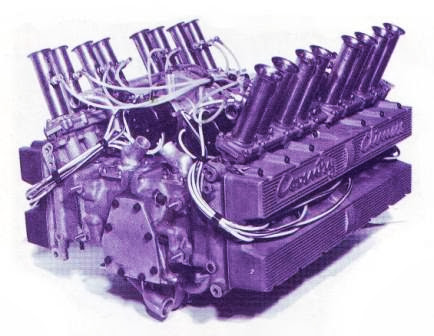kind of car : Classic Engines
car name : Classic Engines
Classic Engines
Classic Engines
Above : The 16-cylinder powerplant used in the racing BRM: fantastically powerful
Once the classic is in motion, the engine does more than any other feature to give it character.. The 1945-75 period started with almost universal use of side-valve power, except on the most costly and exotic cars, and ended with multiple camshafts and valves, fuel injection and unusual materials becoming the norm. Most of these advances were first developed for racing, then refined for road use as they showed the way to efficiency.
Above : The fearsome V-twelve of the racing Sunbeam Tiger. Aero engines were a convenient route to high power.
Progress had meant more performance. Where 1940's power outputs were small, by the 70's, engines in better sports cars were up to 80bhp per litre. Efficiency came from ideally-shaped combustion chambers, usually hemispherical, for which a more complex valve arrangement is usually needed. The simplest way to operate these is by overhead cams, first seen on a Clément of 1902 and used by Alfa Romeo, Bentley and Bugatti in the 20's, MG in the 30's and Jaguar since the 50's, but not used on non-classic until the 80's. It's costly to develop, but usually leads to better breathing.
Above : Alfa Romeo's 2.9-litre engine of the 1930's used a twin double-overhead-camshaft, straight-eight layout.
Further advances included fuel injection, which did away with compromises forced by carburettors. it was first used on production cars, in rather basic form, by Chevrolet on it's Corvette in 1954 and by Mercedes-Benz on its technical tour de force 300SL in 1955. In the early 70's, Bosch's Jetronic systems began to appear on performance classics such as the Porsche 911. Since 1903, with universal fitment of catalytic convertors, fuel injection has become a necessity, along with electronic ignition, which began to appear at the end of the 60's. For convenience, the hydraulic tappet was designed by Bollée in 1910. General Motors began to fit them in the 30's, leading to extra mechanical refinement and less servicing. Hydraulic tappets were universal in America by the 60's; now almost all cars use them.
Above : Classic Italian - the Maserati 250F V12 racing engine with twin camshafts and a separate carburetor choke for each cylinder.
These are some of the milestone power units :
JAGUAR XK
The XK was designed in the Second World War by the nick-named "Firewatchers" Walter Hassan, Harry Mundy and Bill Heynes, when they were on evening fire duty. It is the epitome of the classic in-line twin-cam engine and was sorely needed as an alternative to the pedestrian Standard engines Jaguar was forced to use before an immediately after the war. Launched in the XK120 of 1948, displacing 3.4 litres and producing 160bhp, it enjoyed its finest moment in a road car as the 265bhp 3.8, which propelled the 1962 E-Type coupé to 150mph (241 kph). In 3.0- and 3.4-litre dry-sumped form, it took D-Types to Le Mans wins and powered Jaguar saloons right up to 1987.
ROVER V-EIGHT
a CAST-OFF FROM Buick (the Americans had found themselves good at thin-wall iron casting so there was no need for fancy light-alloy stuff), this 3528cc engine was discovered by Maurice Wilks on a visit to America in 1966. Realising this compact unit would be perfect for powering Rover's big P5 saloon, he quickly acquired the rights. It was a good move: the staid, heavy saloon was transformed into one with a top speed of 110mph (177kph) and 0-60 (96) in 10 seconds.
Above : The light-alloy 3.5-litre Rover V8, beloved of specialist sports car makers, is derived from an unwanted Buick unit of the 1960's
::
so this article Classic Engines
many explanations about classic cars Classic Engines, hopefully can provide many benefits and knowledge, do not forget to wait for next article will discuss other types of classic cars.





0 Response to "Classic Engines"
Post a Comment